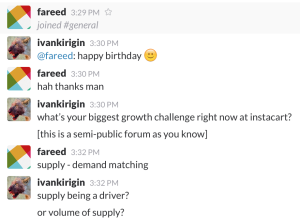
YesGraph is embarking on a new direction, which changes our marketing audience and goals. I recently wrote up some notes on how we should use this blog and other marketing channels. Because YesGraph’s new product is all about helping companies grow, I thought the community would want to see how we think about part of our own growth.
Below is the internal doc I wrote, edited only for clarity for this blog’s audience. I’d love to hear what you think in the comments, on Twitter, on in email: ivan@yesgraph.com
Subscribe to get future YesGraph posts here.
This document lays out YesGraph’s new content marketing strategy. The goal here is to get a cohesive picture of what the next few months look like. We should also flesh out some of the challenges and ways to address them.
What Are Our goals?
This is not immediately a traffic and sales play. We don’t need to drive quantitative metrics. Part of that rationale is that our sales process is ill defined and we don’t have a launched product yet.
Instead, the goal is to impact a few different areas:
- brand
- pre-sales
- recruiting
- press
Brand. We want to establish YesGraph as the best place in the world to learn about how to grow your product. Our content should be world class and authoritative. We’ll do this by writing about what we know, and interviewing experts who know more than we do. When potential customers, employees, and investors do diligence on our company, this content will convince them we’re credible.
Pre-sales. People that want to learn about growth will be qualified leads for our product. Eventually, our content marketing will become part of our sales machine. At the start, I just want to talk to more people that might be customers. This is still an early customer development stage, and funnel optimization for sales isn’t as important as building an amazing product.
Recruiting. We only have a few customers that are live with our API. We don’t have a good demo to show. We also haven’t made any noise in the press. All of this combines to make recruiting harder because convincing people to join our company comes with no background on what we’re about. What we write will showcase what we’re all about. YesGraph can help your company grow. This is an incredibly high leverage position, helping multiple companies at once. It’s also a complex engineering challenge. We have everything we need to convince people to join, and this content is going to help get the word out.
Press. We’re telling an outlier story with YesGraph. We are experts building something every developer needs. It is core to their business, and doing it yourself is hard and won’t work as well. Part of telling this story is showing it. The content we create will help us tell our story to the press. The content itself might be a story too. Our product helps customers, but there is so much knowledge that can’t be productized that we’re writing about it as openly as possible. This fits a good narrative because we’ve already blogged successfully about growth and also about startup ideas.
What Is the Format of the Content?
There are three formats: blog posts about growth, interviews with people about growth, and office hours with companies.
Blog Posts will match others we’ve written on blog.kirigin.com and blog.yesgraph.com. Some examples:
Each of these are thoughtful posts of moderate length covering an aspect of growth. Some are more tactical, others are more strategy.
Interviews are ways of creating compelling content without the overhead of writing clearly. Plus people we interview have their own audiences which can help with the promotion. Most importantly, getting people in the trenches working on growth to tell their story will likely product some really compelling content. Some of the content might be expanded into blog posts.
The format for the interview could be a phone call that is recorded and whose transcript is published as a blog post. Video interviews have the most overhead of production costs but also can make really compelling content.
Office Hours are all about directly helping a startup. We’d cover their goals, what they’ve tried so far, and what they might be able to try going forward. They’ll be recorded phone calls and maybe video calls. The format, like interviews, is better with video but that comes at higher costs.
An issue here is transparency, where maybe companies won’t want to reveal some information. It is most important to get to the truth in office hours, so we’ll allow companies to redact some questions
At the start, our pilot customers make great candidates for interviews. I routinely respond to requests to chat about growth, so the logistics of setting up office hours is really just recording what I’m already doing.
[ed: if you want help with growth and like the idea of office hours, email me ivan@yesgraph.com]
Where To Start?
This outline might make a good blog post. Starting by writing more on our blog is the easiest. Then in parallel we can setup interviews and work through the format.
We should also setup www.yesgraph.com to say the right information about our company, and other such details about capturing an audience.
I have an Asana project with blog post ideas. We should flesh out a few posts to help triage which might be the best to get out soonest. We can double the project to include tasks to setup the blog. I probably won’t go so far as to develop a content schedule besides a frequency baseline: 2 posts per week.
For interviews, I should reach out to a few friends working in growth. For office hours, I should start with companies I already know.
That is it for our internal strategy. Since writing I’ve discussed it with a few others and have refined the plan.
One new addition is a metric to track. Subscriptions to our mailing list is the easiest to track, so go signup here if you like the post: http://eepurl.com/LdRFj
If you have any feedback, let me know in the comments, or get in touch: ivan@yesgraph.com








 Here is a brief tour of what YesGraph does, how it works, and how you can use it. I’ll try to keep it brief so you can get back to work.
Here is a brief tour of what YesGraph does, how it works, and how you can use it. I’ll try to keep it brief so you can get back to work.